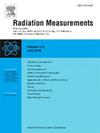使用放射光致发光玻璃(FD-7)和头顶扫描系统快速检测手部意外暴露
IF 2.2
3区 物理与天体物理
Q2 NUCLEAR SCIENCE & TECHNOLOGY
引用次数: 0
摘要
每天使用高强度辐射源的工人有可能意外地将手指暴露在高水平的辐射中,这可能导致皮肤损伤等急性影响。为了及时检测这种意外的严重暴露,我们尝试使用放射光致发光(RPL)玻璃的放射致变色反应,这种玻璃可以用普通的头顶扫描系统戴在手指上。用80-400 Gy的x射线(160 kV, 6.3 mA)照射面积为8.0 × 8.0 × 1.5 mm3的板形RPL玻璃(FD-7),对RPL进行测量是困难的。在示踪光板上目视确认FD-7的放射线致变色反应,并用高架扫描仪(OHS)在一定时间间隔拍摄的RGB图像进行图像处理软件(ImageJ)分析。此外,使用紫外可见分光光度计测量辐照后吸光度光谱的时间变化。在所有剂量(≥80 Gy)下,FD-7的照射后肉眼可见其呈褐色。从OHS获得的倒置图像中,蓝色通道的颜色强度显示出覆盖目标剂量范围的最佳剂量响应。有趣的是,在x射线照射后,蓝色强度立即稳定下来,而无需预热程序,这在RPL玻璃剂量测定中通常是必需的。分光光度测定数据证实了采用顶置扫描系统得到的结果;在辐射后RPL积累期间,蓝色范围(430-490 nm)的吸光度略有下降。这些发现突出了这种监测手部暴露的新方法的实际优势。本文章由计算机程序翻译,如有差异,请以英文原文为准。
Rapid detection of accidental hand exposure using radiophotoluminescence glass (FD-7) and an overhead scanning system
Workers who use high-intensity radiation sources on a daily basis are at risk of accidently exposing their fingers to high levels of radiation, which can cause acute effects such as skin damage. For the prompt detection of such unexpected severe exposure, we attempted to use the radiochromic reaction of radiophotoluminscence (RPL) glass that can be worn on the fingers with a common overhead scanning system. A plate-shaped RPL glass (FD-7) with the size of 8.0 × 8.0 × 1.5 mm3 used in a commercially available ring-type glass dosimeter was irradiated with X-rays (160 kV, 6.3 mA) at 80–400 Gy, for which RPL measurements were difficult. Radiochromic reactions of FD-7 were visually confirmed on a tracing light board, and the RGB images captured at certain time intervals using an overhead scanner (OHS) were analyzed using image processing software (ImageJ). In addition, time changes in the post-irradiation absorbance spectra were measured using a UV–visible spectrophotometer. The post-irradiation brownish coloration of FD-7 was detected by the naked eye at all doses (≥80 Gy). From the inverted images acquired by the OHS, the color intensity of the blue channel showed the most preferable dose response covering the target dose range. Interestingly, the blue color intensity stabilized immediately after X-ray irradiation without a preheating procedure, which is generally required in RPL glass dosimetry. The spectrophotometry data confirmed the results obtained using the overhead scanning system; the absorbance in the blue color range (430–490 nm) slightly reduced during the period of post-irradiation RPL build-up. These findings highlight the practical advantages of this novel method for monitoring hand exposure.
求助全文
通过发布文献求助,成功后即可免费获取论文全文。
去求助
来源期刊

Radiation Measurements
工程技术-核科学技术
CiteScore
4.10
自引率
20.00%
发文量
116
审稿时长
48 days
期刊介绍:
The journal seeks to publish papers that present advances in the following areas: spontaneous and stimulated luminescence (including scintillating materials, thermoluminescence, and optically stimulated luminescence); electron spin resonance of natural and synthetic materials; the physics, design and performance of radiation measurements (including computational modelling such as electronic transport simulations); the novel basic aspects of radiation measurement in medical physics. Studies of energy-transfer phenomena, track physics and microdosimetry are also of interest to the journal.
Applications relevant to the journal, particularly where they present novel detection techniques, novel analytical approaches or novel materials, include: personal dosimetry (including dosimetric quantities, active/electronic and passive monitoring techniques for photon, neutron and charged-particle exposures); environmental dosimetry (including methodological advances and predictive models related to radon, but generally excluding local survey results of radon where the main aim is to establish the radiation risk to populations); cosmic and high-energy radiation measurements (including dosimetry, space radiation effects, and single event upsets); dosimetry-based archaeological and Quaternary dating; dosimetry-based approaches to thermochronometry; accident and retrospective dosimetry (including activation detectors), and dosimetry and measurements related to medical applications.
 求助内容:
求助内容: 应助结果提醒方式:
应助结果提醒方式:


